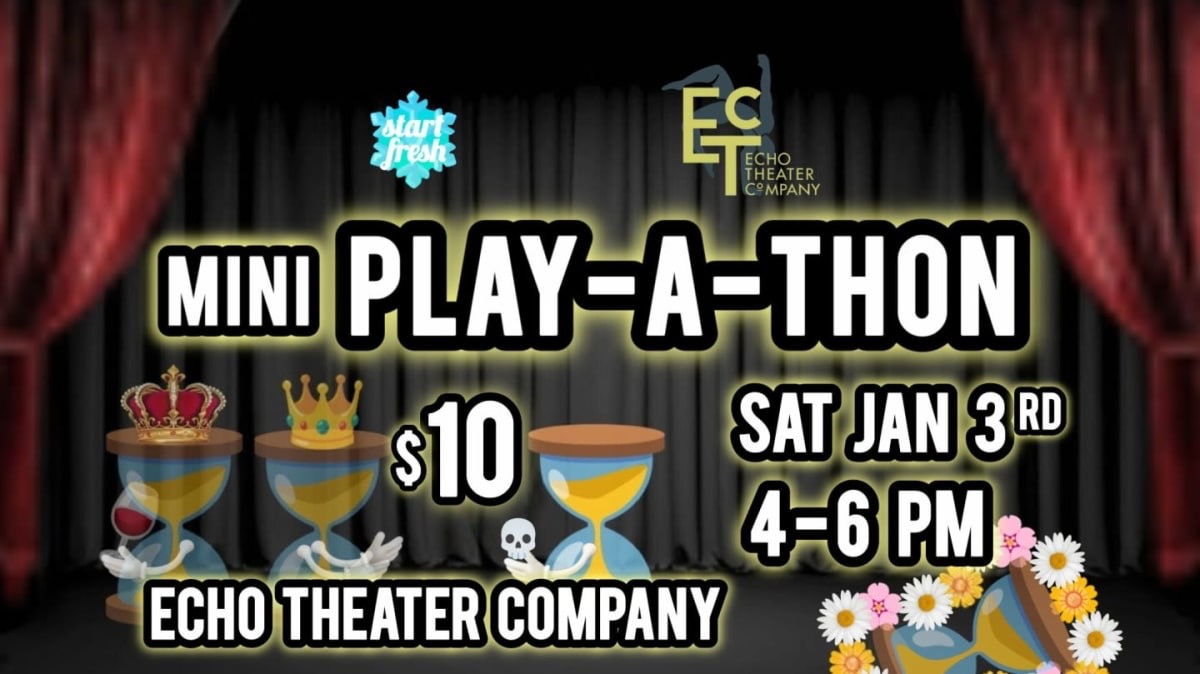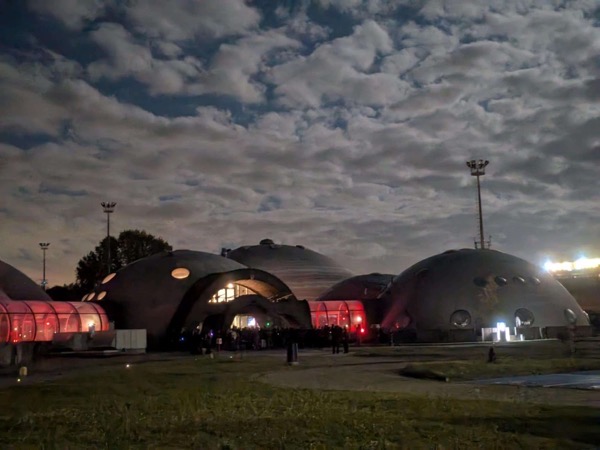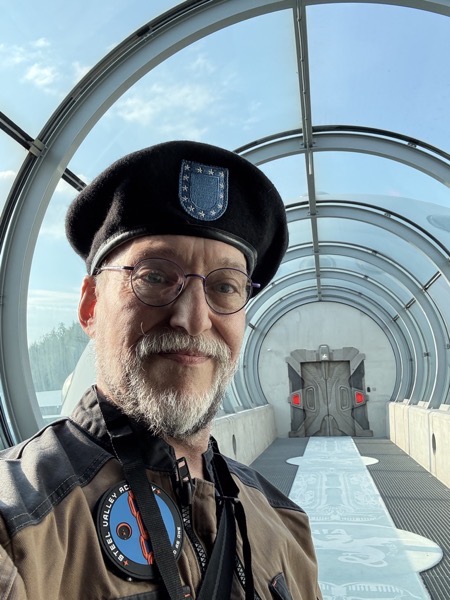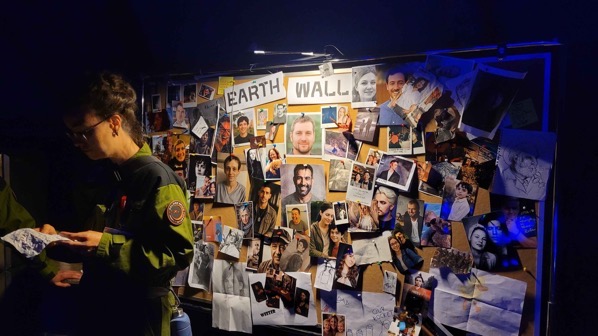I am writing at the airport on the way home from Philadelphia, where I played in the Miskatonic University North America LARP organized by Chaos League in conjunction with Reverie Studio. This was a Live Action Role Play game loosely based on the stories of H.P. Lovecraft, which took place at Miskatonic University in Arkham, Massachusetts in 1924.
This report contains SPOILERS.
Miskatonic NA is an “International Blockbuster LARP,” which means that it had a large cast (about 116 players), an immersive setting (the delightful and historic campus of Bryn Mawr University), and very substantial advance preparation by the organizers and players to deliver a fully immersive experience. Each player was preassigned a character with a detailed background and personality traits — my character sheet was nine single-spaced pages — and we were expected to arrive with appropriate costumes and props for the 1924 setting.
Up until this year, all the international blockbuster LARPs I have played in have taken place in Europe (except for Expedition Sahara which was in Tunisia). However, beginning this year the European LARP phenomenon seems to be migrating to the United States, and in many cases these LARPs are games which have originally been presented in Europe and are now being run in the US with a US partner. In this case, Miskatonic University had been run seven times in Poland by Chaos League, and they were now teaming up with Reverie Studios to run it twice in Pennsylvania. I participated in US run 2. (In 2026 I plan to play in two other LARPs that have been similarly ported from Europe to the States: Bard’s Tale and Conscience.)
Although this game was inspired by the works of H.P. Lovecraft, it wasn’t based on any specific Lovecraft story and it certainly did not include Lovecraft’s sexism or racism. Characters were all written without specifying gender or race; the players, mostly American, represented a variety of backgrounds (admittedly, mostly white) and a broad diversity of gender identities and presentations. What the game did draw from Lovecraft was themes of madness and “cosmic horror.” This was not the kind of horror LARP in which costumed NPCs jumped out from behind pillars to frighten the players — the horror was instead existential and subtle.
The game took place in the last three days of the 1923-24 academic year. Most of the characters were first-year students, with a small number of players being professors (these players were responsible for creating their own lectures and exercises, and they all did fabulously with them). A few non-players portrayed more advanced students, other faculty members, and staff. Every student had an academic course of study — my classes were in anthropology and ancient languages — and belonged to one of six “Societies” (these weren’t secret societies, more like fraternities) each of which had its own traditions, rituals, and flavor.
Life at Miskatonic was pretty much like life on any college campus. Some students were focused on their courses, others on socializing, and others on various e/x/t/r/a/t/e/r/r/e/s/t/r/i/a/l extracurricular activities. The players’ days were fairly heavily scheduled, with meals (provided by the campus food service, and quite good they were too), lectures, labs, Society events, and scheduled campus activities. But there was also a lot of free time, and students were also free to skip out on classes or other activities and/or stay out after curfew… and face the consequences of doing so. Every player made their own choices about how to spend their time, and so everyone had a different experience. No one got a lot of sleep.
Each player’s experience was very heavily influenced by their Society. A character’s Society was so central to their game that all characters’ names began with the same letter as the Society, so you could tell immediately when seeing someone’s name tag or even hearing their name which Society they belonged to… and hence a lot about their personality, priorities, and goals. My Society, the Lost Poets (whose names began with L), was focused on the arts; we spent a lot of our time talking about, making, and performing or presenting poetry, prose, theatre, painting, and drawing. The Enigma Society (E names) focused on solving puzzles, many of which were connected to the mysterious sarcophagus which had recently been discovered in the archives and was the center of the game’s overarching plot. The Mind’s Eye Society (M) was dedicated to psychology and the other sciences, while the Knife and Veil Society (K) was dedicated to the occult; they didn’t get along well at all. The remaining societies were Goliard’s Thorns (G, the goths) and Order 322 (O, the fascists), also traditional rivals. In general, students spent most of their non-class time with other members of their Society.
My character, named Lawson, was a poet. He had been born poor in Dublin, had made his way to America to seek his fortune, and had failed utterly there, winding up penniless, drunk, and sleeping on the street. He’d been a brawler and a drunkard and had hurt a lot of people, and making amends with those people was a big part of the character’s agenda for the weekend. But then one night he staggered into a cafe and berated everyone there with his lewd and insulting poetry. He’d been arrested for that, but some of those present were sufficiently impressed by his poetry and delivery that they took up a collection to bail him out… and one of them had been a publisher, who’d offered him a contract. Since then he’d become a rich and successful poet. Now, having made sufficient enemies in society that he needs to avoid the limelight for a while, he’s attending Miskatonic as an adult student, and really enjoying it. I chose to play the character with an Irish accent, and though I was a bit worried about maintaining it or getting in trouble for cultural appropriation, many people later commented that they’d been impressed by it.
When we showed up on the first day of the game our first agenda was moving into the dorms, which felt a lot like moving into the dorms in real life. We all met our fellow players — many of whom our characters had extensive backstory with but whom we were meeting in person for the first time — unpacked, and pinned our names and other ephemera to the cork boards outside our rooms. Then we all trooped down to the gorgeous Old Library for the usual half-day of workshops, in which we were introduced to the rules, metatechniques, and expectations that would keep players physically and emotionally safe, then had an opportunity to meet and coordinate with our characters’ close associates, fellow Society members, and study-group compatriots. Then we all got into costume and the LARP proper began.
My character, somewhat against my expectations, was more involved with his actual classes than with the mystery around the sarcophagus or intracollegiate shenanigans. The players who portrayed the professors were amazingly good at their jobs, providing fascinating and engaging lectures and exercises. Professor Petkov — one of the main “villains” of the piece, being a hardass and a sadist — was actually the most engaging teacher (and a fantastic player) and my character wound up respecting her intellect enormously. It didn’t hurt that she had a habit of breaking up the class into competing teams for group projects and my character’s (okay, my) group projects tended to win the competitions.
Outside of class my character engaged strongly with the Lost Poets, and these hours were among the most enjoyable and heartwarming of the game for me. We bonded fast and deeply, and had many late-night discussions on the meaning and purpose of art. The Lost Poets may not have investigated sarcophagus-related puzzles like the Enigma Society or conducted seances and exorcisms like Knife and Veil, but we were a real fount of gossip and our gala exposition (talent show) on Saturday night was a highlight of the game for many, not just in our Society. I really felt like I had met my found family in the Poets and I can’t imagine myself having been happy in any other Society. (I might possibly have said the same if I’d wound up an Enigma or Knife and Veil character, both of which I’d considered, but I would have had a completely different game.)
One of the key moments of the game for each player was their turn to read from the Forbidden Texts — a powerful mini-game within the game — after which, having been exposed to forbidden knowledge, our characters would begin to Descend Into Madness. For my own Descent, my character sheet told me that I would write a poem full of horrific imagery in which I imagined violently slaughtering my closest friends. But as I had spent much of the game making amends with people to whom I had done physical violence, and in each case I had expressed true remorse and a promise that I wasn’t really like that and would never do such a thing again, I felt that a poem involving physical violence would be too much of a blow to those recently-repaired relationships. Perhaps, in the spirit of “drive your character like a stolen car,” I should have gone ahead and done that. But I didn’t, and instead I chose to attack them psychologically instead. Since in this game everyone’s character sheets were open for all to read, I could look into my friends’ souls and find out exactly what I could say that would hurt them the most. I would write a cruel, insulting poem in which I plunged my knife deeply into my closest friends’ most tender and secret vulnerabilities.
My initial intention had been to just gather a few people together to read this poem, but with the upcoming exposition I realized that it would have more impact if I delivered it there. So I whipped out the poem in the hour between dinner and the exposition, then sat nervously waiting for my turn to come up. As I waited I realized that I couldn’t just step calmly to the podium and deliver this horrific screed, so I began to stare and tremble and mutter in my seat. Several people, concerned, came over and asked if I was doing okay, but all I replied was “black… black… everything is black” and “the show must go on, the show must go on.” When my turn came I charged onto the stage and delivered the poem with great vigor, gusto, and anger, and when I came to the last lines — in which, of course, I was cruelest to myself — I collapsed in tears on the floor. Many people came and helped me up, and I expressed surprise at finding myself on stage. The last thing I remembered was being in the audience. Had I fallen asleep and missed my cue? But no, they told me what I’d done and showed me the poem I’d delivered — written in my own notebook in my own hand. I read it and was utterly appalled, and ran around apologizing profusely to everyone I’d insulted. Fortunately they all forgave me, though for some it took a while. And, in a weird parallel to the cafe incident from my backstory, many many people came up to me and said that my poem and delivery had been exceptional and superb.
The other most memorable scene for me took place the following evening, before the climactic Gala that would conclude the game. Because by this point in the game everyone had been exposed to the Forbidden Texts, madness was endemic, and having already gone through my Descent and come out the other side I found myself, rather against my expectations and intentions, being one of the few trying to keep the Society on track to play our part in the Gala. One of the Society’s three Masters announced he was getting on a train to Carcosa (a location from the forbidden text The King In Yellow) and had to be gently restrained. But, hilariously, the character’s player was indeed getting on a train that evening, as he had to leave the game early, and so the character escaped. Another Master seemed to be doing all right until I noticed that she was scribbling maniacally in her notebook, and so I tried to talk her back to herself.
And then one of my best friends, a playwright named Little, returned from wherever he’d been hiding after nearly killing three people in a performance-art-piece-turned-chemistry-experiment… an amazing scene to which I’d been fortunate to witness the conclusion. He was still quite mad, with blood on his face (“don’t worry, it’s not mine”), but I took him aside, grabbed his shoulders, and told him that he was a playwright, not a chemist or a war criminal, and if that he’d just listen with his heart he could return to being his own true self. It was a long and impassioned speech — the scene, which involved just the two of us, ran to perhaps twenty minutes — and at the end of it he coughed up whatever foul spirit had been clogging his lungs and began to act somewhat more normal. But as we walked off to the Gala behind our Society banner I continued to be worried that he might relapse, that the Master who was still scribbling in her notebook might wander off, or that another friend — who was raving about some scheme to prevent the return of the evil elder gods which I judged had no chance of success but was also unlikely to make things worse — might do something desperate.
At this point half the students were mad, multiple schemes to save or destroy the world were proceeding, and I was convinced that whatever had been released from the sarcophagus would surely end us all — Miskatonic University at least, perhaps the Eastern Seaboard, perhaps the world — but, in the end, we all wound up dancing the evening away and only a few people died. The true cosmic horror would not be released until later, when an expedition from Miskatonic found the lost city of Zerzura in the Sahara Desert.
I believe that Sahara Expedition was written first and Miskatonic University later, as a prequel. I can recommend both games and I think they can be played in either order. Miskatonic University wasn’t as intense as Sahara Expedition but it was nonetheless immersive, emotionally engaging, and beautifully run and had a fantastic setting with many subtle but effective props and special effects. I can wholeheartedly recommend it and any other productions from Chaos League.




Recent Comments